#lord orochi
Text
Orochi smiling is absolutely adorable


64 notes
·
View notes
Text

“Let me take care of you…”
I don’t think Orochimaru enjoyed being a kept man after the Konoha Crush, but I don’t think Kabuto was too broken up about having to take care of his every need. What would he have done without him?
When I first watched Naruto, I thought “OroKabu” was canon. I thought how wonderful and progressive it was to have a gay couple in an anime… Imagine my surprise when I found out other people didn’t agree. I mean what was more gay than them? Oh that’s right, Naruto and Sasuke ^^;
This was supposed to be a quick little drawing, and then suddenly four days of painting happened.. I hope you like it. As always, re-blogs and shares are much appreciated. Feel free to repost on other sites, but a credit would be appreciated xx
#orochimaru#anime art#legendary sannin#fanart#lordorochimaru#naruto#ventriclealchemy#anime and manga#anime#Lord Orochimaru#kabuto yakushi#kabuto#orochimaru fanart#realistic orochimaru#orokabu#Orochimaru x Kabuto#naruto fanart#orochi#my art
90 notes
·
View notes
Text
Easter Day
Happy Easter y'all! Presenting my works from today's to a few years ago :>
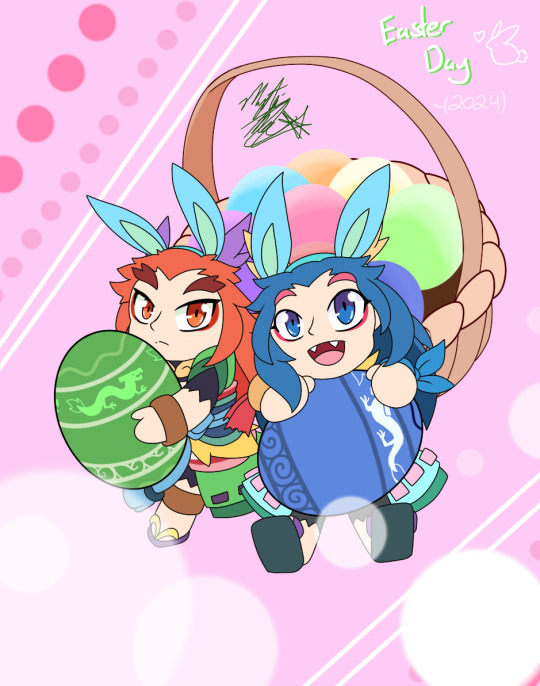
Last year's Easter

pretty sure this one is made in 2019???

#youkai watch#yo kai watch#youkai watch au#yo kai watch au#dragon lord#azure dragon#venoct#orochi#tsuchigumo#arachnus#easter
7 notes
·
View notes
Note
thoughts about zoro x hiyori ship? /srs
anon, don't take this the wrong way and hopefully this will apply to any other questions I could get abt this sort of thing, but I'd appreciate not being asked my opinion on ships unless I've actively mentioned liking them beforehand otherwise I'm more likely to ignore/delete. I don't mind discussing ships in dms and such (iirc I changed my settings a while back so I can receive messages from anyone) but I'd rather avoid any negative talk abt ships on public posts, in case someone mentions one I dislike. I'm just as biased as anyone else out there y'know?
now, to answer your actual question - I don't have deep thoughts on it tbh. I liked their interactions in wano and I don't strictly hc zoro as gay either, more on the demi side actually so it's not like I mind on principle anyhow. in a way they're always gonna be somewhat connected too? bc of enma. I really liked hiyori as a character herself so mostly if I see anyone hating on her simply bc they prefer other zoro ships (typical "gets in the way of my ship" hate) or make "misogynistic zoro" jokes abt that one scene from the anime, I'm going to block on sight.
#I've seen ppl complain abt zoro not following through with offing orochi#but this is like.....he had no business here. I'm glad hiyori got her moment bc lord knows#she deserved to see that fucker dead#tp#replies
4 notes
·
View notes
Text
"You can tell that Gan Ning's a wild man."
Citizen in Dynasty Warriors 9 after Gan Ning joined Wu.
#Text#Dynasty warriors#DW9#Gan Ning#He IS quite wild man haha! :'D#I even saw a post yesterday where Gan Ning said - in Warriors Orochi - to Nene#That he never listened to his mother when she was still around#And that he's not going to listen Nene either#But I also saw today someone in DW9 say: “Lord Gan Ning's bells never ring again...”#This was after Gan Ning was killed by Shu army#That one person was the only one who ever had said anything about Gan Ning after he died
10 notes
·
View notes
Text
my pet peeve is when im playing any kind of action game nd the guys have ugly moans when they get hit.....put some horniness on that beast will you?
14 notes
·
View notes
Note
Can I request a yandere Katsumi who has the hots for his first and only female student?
It feels a little bit like presenting a dish before Gordon Ramsay on Hell’s Kitchen or something, but as you wish ma’am. Let us hope I don’t make a donkey out of myself.
Yandere! Katsumi Orochi x Student! Reader
Featuring the karate prodigy and a female reader that’s impressed him beyond just fighting skills.
[Baki Masterlist]
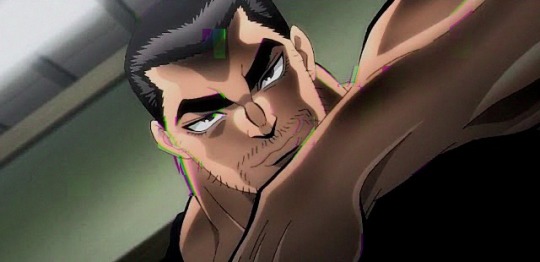
It’s not a given for everyone, but some people just seem to be gifted for a particular vocation, inclined towards a certain calling. While Katsumi is widely envied for his quick learning and masterful karate prowess, the one place where he shines most, where his skill is unequivocally unmatched, is in the dojo. Specifically before students. One can easily tell him apart, even among names of greater authority such as Doppo Orochi. Pupils naturally flock to him, you included.
Your case, however, is a little bit of an exception. Out of random circumstance you happen to be the only female student at the Shinshinkai Dojo. Truth be told, Katsumi had opposed your membership at first. He takes pride in his neutral approach and equal treatment when it comes to his pupils. So when the men started to whisper, snicker and whistle secretly behind your back, he could only grit his teeth in shame and frustration. He would’ve liked to scold them, tell them that this is a sacred place dedicated only to martial arts and other temptations are to be kept strictly out. But he, too, found you attractive. He would’ve been lying to everyone, including himself. Hereby the conflict: accepting you as a student would’ve been tainted by impure thoughts, but denying to train you would’ve stripped him of his dignity as a teacher. He promised to fix his inappropriate attitude instead; after all, discipline is part of the art.
All that being said, he doesn’t regret his decision. You’re awfully talented and often remind him of his own karate journey. You only need the slightest push in order to grasp most techniques and you’ve gone above and beyond his expectations in conquering the basics. The veiled, flirty glances from the other fighters have been replaced by somber, respectful nods as your reputation continues to increase with each rank. Katsumi would go as far as calling you a true prodigy. Admiration aside, only one small issue remains: not only has his initial crush remained with stubborn vehemence, but it appears to have turned into full blown, sickening infatuation. To put it mildly, he’s obsessed.
Is he really to blame here? It’s as if everything about you has been carefully chiseled to his liking. “Then the Lord God made a woman from the rib he had taken out of the man, and he brought her to the man. The man said, ‘This is now bone of my bones and flesh of my flesh; she shall be called ‘woman’, for she was taken out of man.’” You are the Eve to his Adam, a genesis of love that was fated to return to him. There is no other explanation. Indeed, the more he tries to rationalize it, the clearer his purpose becomes. Out of all the places, the timelines, the people, the fact that against all millions of variables your encounter settled on him…His desire is not to be disciplined. Not anymore. One has to acknowledge the ridiculousness of battling destiny itself.
Then he shall no longer tamper with matters that are predestined. In fact, he might just lend fate a helping hand. His patience is reserved for teaching, not romantic affairs. He needs an opportunity to have you alone without interruptions, and conveniently enough you’ve asked him to stay behind today. You can barely conceal your cheeky smile as you slide the canvas door open. As promised, Katsumi is standing near the wall, hands folded behind his back. You can feel your heart pounding, but you muster up the courage to approach him. You’ve been training hard and he’s had nothing but praise for you. A nervous blush tints your face as you bat your eyelashes, calculating your next words. Katsumi’s eyes narrow in adoration. It’s alright, he knows. “How may I help you, (Y/N)?” He nudges you expectantly. “I’ve been wondering about it…I was afraid of your response, but I need to let it out nonetheless. I think I’m ready for the next step.” Oh God, here it comes. He can barely contain himself. Just say the words, and he’ll take you right here and now. “I know it hasn’t been that long, but I really think I’m ready for the upcoming competition. Is there truly no way for me to sign up, even with my current belt?”
Huh. His mouth hangs open for longer than he would’ve preferred. Is this…is this why you’ve called him here? He looks around the room, as if expecting some cameramen to pop out and announce it was all a prank and (Y/N) actually meant to confess her unwavering attraction to him. Your smile slowly fades seeing his increasingly frantic expression. He grunts. “I’m sorry, if you think I’m not ready yet I can-“ He lifts a hand to your face and firmly grabs your jaw. Shut up, please. He walks over to the door, pulling you after him, and hastily checks the hallway for people. It’s empty. With the other free hand he slams the door shut. The dojo will remain closed until morning at least. Plenty of time to set you straight. It’s fine, he’s calm. Oh, you silly, sweet darling (Y/N). He loves this innocent obliviousness of yours. There are other important matters at hand. You try to remove his fingers from your face, but Katsumi’s arm is tense and stiff, refusing to budge. You’re suddenly very cold. His gaze is different and it scares you. You don’t recognize the possessed, hollow eyes that pierce into you. But here’s where you’re mistaken, they’re not hollow at all. On the contrary, they’re overflowing with adoration and worship. You just haven’t realized it yet.
#baki#baki the grappler#baki hanma#yandere Baki#baki headcanons#baki x reader#katsumi orochi#katsumi orochi x reader#yandere
313 notes
·
View notes
Text
Demon king, demigod, drunkard, dōji: exploring the archetypal oni, from Ōeyama to Lotus Eaters
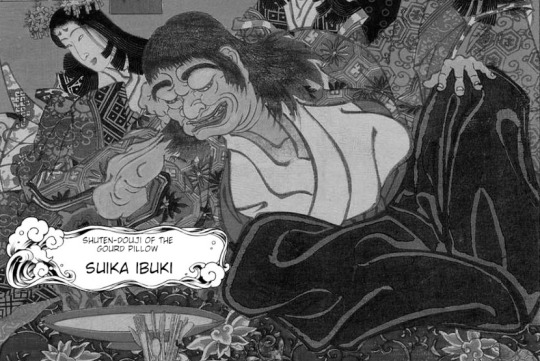
By popular demand, I wrote an article covering the background of Shuten Dōji and his underlings, and how it influenced Suika’s character and the idea of the Four Devas of the Mountain in Touhou. It was initially scheduled for last month, but I’ve experienced unplanned delays.
Read on to learn if you want to learn what Suika has to do with Yamata no Orochi and Mara, if it’s true that oni never lie, and more. I will also explain why making your own fourth Deva of the Mountain is entirely fair game and anyone telling you otherwise is wrong about the source material which inspired ZUN.
The article contains some spoilers for WaHH and a number of other Touhou installments, so proceed with caution if that might be an issue for you.
Ōeyama, or Shuten Dōji: origins
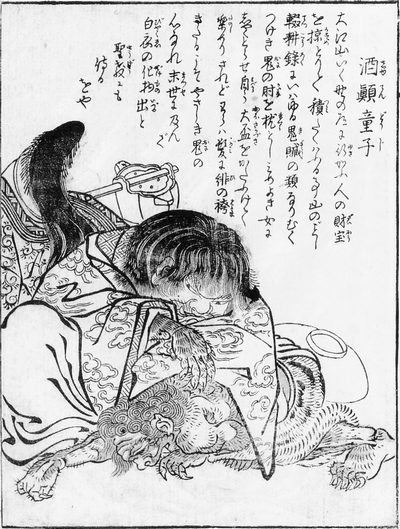
Shuten Dōji, as depicted by Sekien Toriyama in Konjaku Gazu Zoku Hyakki (wikimedia commons)
It perhaps seems a bit silly to start this article with an inquiry into the identity of Shuten Dōji (酒呑童子, “wine-loving youth” or something along these lines). After all, while Touhou characters are often based on obscure figures, Suika is hardly an example of that category. Shuten Dōji is arguably THE archetypal oni, known even to people with limited familiarity with Japanese mythology and folklore. And yet, the matter is nowhere near as clear cut as it might seem at first glance. From a certain point of view, Shuten Dōji might not even exactly be an oni, strictly speaking.
A book from Nara simply titled Ōeyama ("Mt. Ōe") offers a detailed account of Shuten Dōji’s origin. His father was not a man or a demon, but rather a mountain god, Ibuki Daimyōjin (伊吹大明神). That’s not all, though - according to a local belief, Ibuki Daimyōjin was actually Yamata no Orochi. How does that even work? Contrary to the more widespread tradition, the inhabitants of the area around Mt. Ibuki from the Muromachi period onward believed that Orochi survived his confrontation with Susanoo and hid in the mountains.
That’s actually not even the most unusual variant tradition about Orochi. A widespread belief through the middle ages was that he eventually managed to redeem himself, becoming a divine dragon (shinryū, 神龍) residing in the dragon palace under the sea. In that capacity, he was sometimes associated with emperor Antoku, with the latter even claimed to be his reincarnation, for example in a local legend associated with the Atsuta Shrine, preserved in the noh play Kusanagi. In esoteric Buddhist doctrine Orochi was sometimes perceived as a local manifestation (suijaku) of the buddha Yakushi - much like Susanoo was.
Ichijō Kaneyoshi in his Nihon shoki sanso (1455–1457) went into yet another direction, presenting the snake as identical with the naga girl from the Lotus Sutra. Apparently, he specifically means the version of her from Shaku Nihongi… who is identified there as Susanoo’s wife, down to being equated with Kushinadahime (this was not unusual in itself - Susanoo was equated with Gozu Tennō based on similar character, so it was sensible for their wives to be seen as analogous). This effectively created a scenario where Susanoo married his nemesis.

A Japanese depiction of the naga girl offering a jewel to the Buddha, as described in the Lotus Sutra (wikimedia commons)
Anyway, back to Shuten Dōji. According to Ōeyama, Ibuki Daimyōjin, before he even came to be known under this name, fell in love with the daughter of a local feudal lord, Sugawa. He started visiting her at night and she as a result eventually became pregnant. The identity of the visitor was unknown to her father, and out of frustration and fear that nefarious supernatural forces might be involved he eventually contacted various religious officials to perform exorcisms. Needless to say, Ibuki Daimyōjin was less than thrilled, and decided to display his divine wrath through rather conventional means: Sugawa was struck by illness. He once again summoned various Buddhist monks and onmyoji, this time to attempt to heal him. They concluded that the disease will disappear if the deity who caused it is properly honored, and established formal worship of Ibuki Daimyōjin, which apparently did indeed help.
Sugawa’s daughter eventually gave birth to Ibuki Daimyōjin’s child. The child started to cause problems at the age of three: his love of alcohol manifested for the first time, earning him the moniker of Shuten Dōji. By the time he was ten, his misdeeds were too much for his family to bear with and his grandfather decided to send him to Mt. Hiei to become a novice (chigo). The monastic lifestyle didn’t really change much though, and Shuten Dōji continued to drink. Eventually he managed to convince three thousand monks (sic) to drink with him and to join him in an “oni dance” during which everyone put on masks representing demons. The festivities lasted seven days. When Shuten Dōji woke up afterwards, he realized his mask had fused with his face, and he was no longer able to take it off. The other participants fled out of fear of his new form.
Shuten Dōji’s Mt. Hiei career was subsequently cut short by Saichō, the founder of the Tendai school of Buddhism. After learning what happened, he prayed to the buddha Yakushi and to Mt. Hiei’s protective deity Sannō Gongen to banish Shuten Dōji. It's worth pointing out that presenting young Shuten Dōji and Saichō as contemporaries is basically standard, and pops up in multiple legends. There are variants where Kūkai, the founder of Shingon, plays a similar role instead, to. They actually lived some 200 years before the other historical figures who appear in Shuten Dōji narratives, but this is not an oversight. It is a given that a partially divine being would live for much longer than a human.
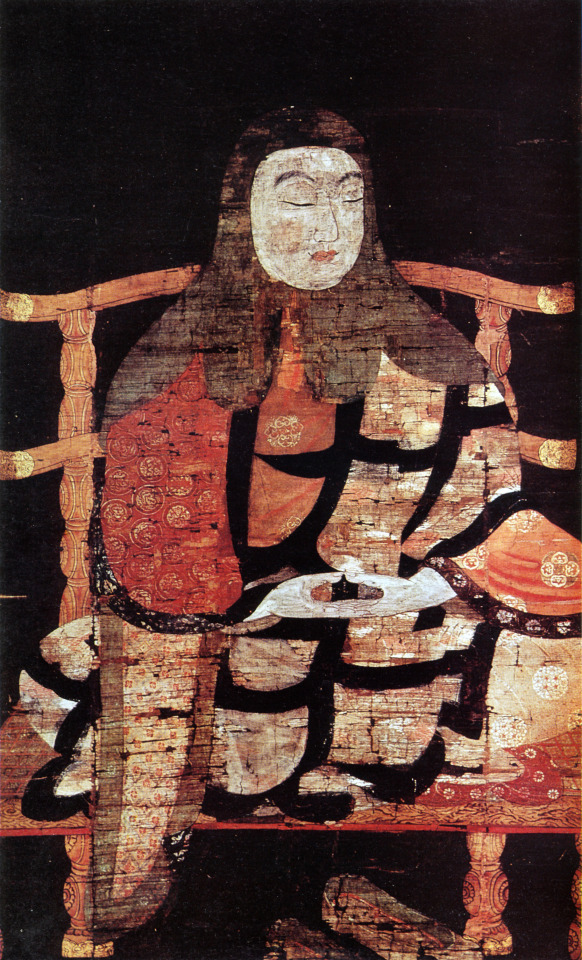
A Heian period portrait of Saichō (wikimedia commons)
As a result of Saichō’s success, Shuten Dōji had to flee. He tried to return to his grandfather’s residence, but this was no longer an option for him. He temporarily hid on Mt. Ibuki, but eventually left for Mt. Ōe, where he finally became a veritable "demon king".
The reason why Shuten Dōji was rejected by his family is that he was recognized as an “oni child” (鬼子, onigo). In the folkloric sense, this term refers to supernatural beings which are nonetheless partially human by birth. Not necessarily part oni, though. Another well known onigo, Sakata no Kintoki, was the son of a yamauba, for instance.
However, Yanagita Kunio noted that this term also referred to children born with teeth (a real, though very uncommon phenomenon), who were believed to turn into oni - much like how Shuten Dōji did. He states that especially before the Edo period this lead to cases of child abuse or outright murder. In some cases sending the child to become a member of Buddhist clergy was seen as a remedy. For example, a twelfth century monk named Jōjin in a letter relays that he suggested this to the mother of such a newborn. It is not hard to see that Ōeyama likely consciously references this custom.
The other origin of Shuten Dōji
Yet another tradition is preserved in a variant of the standard Shuten Dōji tale which switches the location of his demise from Mt. Ōe to Mt. Ibuki: here Shuten Dōji is not just any demon, but a manifestation of Mara. As in, the opponent of the Buddha and demon king of the sixth heaven, not some other accidentally similarly named figure.
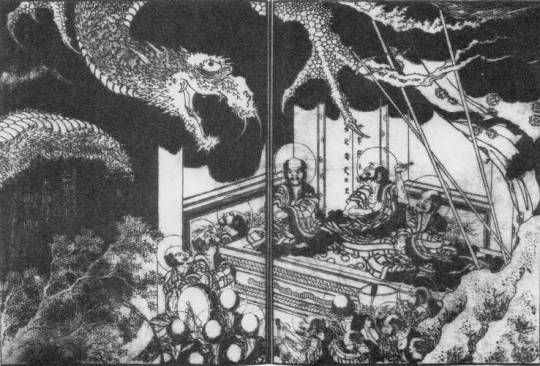
Mara, as depicted by Hokusai in Shaka-goichidai-zue (wikimedia commons)
It is presumed that this portrayal of Shuten Dōji might be tied to medieval Japanese traditions pertaining to Mara. They might sound unusual today: he was both a “demon king” (魔王) obstructing enlightenment, as expected, but also a jinushi (地主), or “landholder deity”. From the Buddhist point of view, jinushi were ambivalent figures: on one hand, their presence was responsible for bestowing specific locations with holiness. On the other hand, they could resist Buddhism as demonic forces, and had to be subjugated or converted to prevent that. Mara was the ultimate jinushi, the king of the world as a whole. A role already attributed to him in earlier Buddhist sources was basically adjusted for this framework.
The jinushi version of Mara originated among proponents of the imperial court and mainstream Buddhist institutions, but it curiously also gained traction among the opponents of these structures. Mara became somewhat of an anti-establishment icon more than once, essentially. A legend links him with (in)famous rebel Taira no Masakado (who you may know from SMT) for this reason.
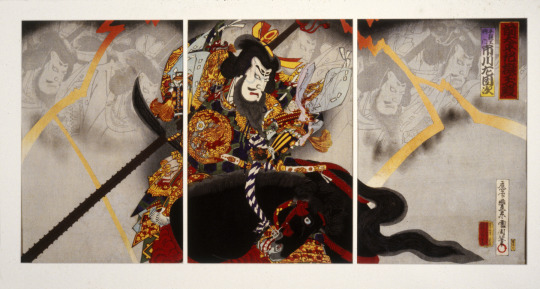
Masakado, as depicted by Kunichika Toyohara in Sen Taiheiki Gigokuden (wikimedia commons)
Other similar examples are also known. A local legendary figure from the Tsugaru peninsula in modern Aomori prefecture, Tsugaru Andō (津軽安藤), who after a failed rebellion fled to Hokkaido, was proudly described as a vassal of Mara by local officials who claimed descent from him. Prince Sutoku, a banished opponent of emperor Go-Shirakawa, swore a vow to become like Mara. Oda Nobunaga famously referring to himself as the “demon king of the sixth heaven” in a letter to Takeda Shingen is likely another example.
Reportedly a related belief that praying to the jinushi version of Mara can spare one from conscription persisted as late as the early 20th century, though generally he belongs to the realm of “medieval myths” which faded with the ascent of a new system of values in the Meiji period, in which the early imperial chronicles were favored. Even though it is largely forgotten today outside of specialized scholarship, there is much more to this Mara tradition. It led to the development of one of my favorite Japanese myths with no popcultural reception, but you will have no wait a few more weeks to learn more.
It has been argued that behind the identification of Shuten Dōji and Mara might reflect a historical event of the sort which led to associating the latter with figures such as Masakado. In other words, that Shuten Dōji in this case might be less a demon and more a demonized form of some opponent of imperial or religious authorities.
It has been argued that the Ibuki version was the result of combining an original oral narrative, a precursor of the textual versions we are familiar with today, with the memory of the death of a certain Kashiwabara Yasaburō, a bandit leader, in 1201. It has in fact been argued that even the mt. Ōe version might simply be a particularly fabulous reinterpretation of a punitive mission against bandits robbing and murdering travelers. Such rationalist explanations are not exactly new - Ekken Kaibara already argued in the Edo period that the legend of Shuten Dōji must have been the reflection of the downfall of a real bandit who perhaps wore the mask of an oni while committing robberies.
It’s important to bear in mind to not go overboard with this speculation, though. Ultimately the Mt. Ibuki version has a more pronounced religious character than other variants in general: Shuten Dōji’s nemesis Raikō’s is identified as a manifestation Bishamonten or Daiitoku Myōō (in the latter case, Bishamonten and the three other heavenly kings correspond to his four retainers), emperor Ichijō with Miroku (Maitreya), and Abe no Seimei, who plays a minor role in vanquishing the demon, with Kannon.
These equations reflect the idea of honji, or “true nature” of Buddhist figures, who were believed to take various guises through history to help people reach nirvana, for example these of local deities or historical figures. The best known example of application of this doctrine in Japanese Buddhism is obviously the historical phenomenon of honji suijaku, which was focused specifically on kami.
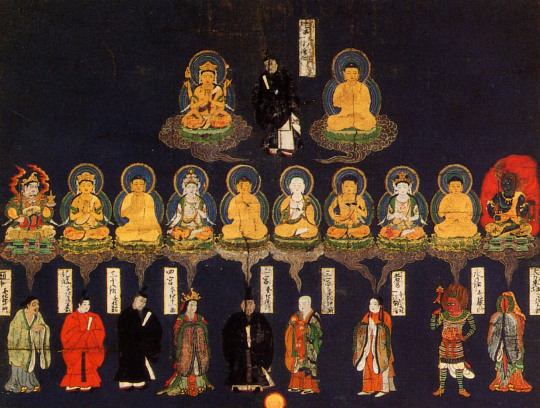
A Kasuga mandala representing the correspondences between Buddhist figures and local kami (source; reproduced here for educational purposes only)
The legend of Shuten Dōji
Regardless of which mountain is identified as the residence of oni, and of whether the dramatis personae are identified with Buddhist figures or not, the plot of the various versions of the legend of Shuten Dōji surprisingly does not vary all that much. While it is reasonably well known, I figured it won’t hurt to summarize it here anyway, especially since the information above should make it possible to view it from many new angles.
The oldest surviving version, Ōeyama Ekotoba (“Illustrations and Writing of Mt. Ōe”), presumably based on preexisting oral sources, comes from the fourteenth century, specifically from the Nanbokuchō period. However, the story only reached the peak of its popularity a few centuries later, in the Edo period. This was a part of a broader phenomenon: preexisting tales about warriors matched the sensibilities of the new ruling classes and were kept in circulation by them, but eventually they also became a part of urban popular culture. Many adaptations were produced, including noh plays and ukiyo-e. To put it very colloquially, the heroic warriors and demon quellers from the previous periods became the Edo period counterpart of contemporary superhero media. This is a genuine comparison employed in scholars, for clarity, not a joke.
As remarked by Bernard Faure, the most widespread version is basically framed as if it was a tabloid story from the Heian period. In 995, young women (and in some versions men too) disappear whenever a particularly violent storm occurs, and nobody knows how to stop it. Not even the power of Buddhist exorcisms is enough. Seeing as in the portrayed time period that was pretty much the universal solution to supernatural problems, this is a big deal.

Abe no Seimei (right) in the Fudo Rieki Engi (wikimedia commons)
This is a source of distress for a certain official, Ikeda Kunikata (or, in some version, Kunitaka), whose only daughter is among the kidnapped women. He decides to seek the help of the Heian period superstar Abe no Seimei, arguably the most famous onmyoji in history. Alternatively, the expert contacted is a certain Muraoka no Masatoki, who to my best knowledge is a fictional character and doesn’t appear anywhere outside of some variants of this tale.
Either way, thanks to this intervention it is possible to identify the culprit as a demonic being residing on Mt. Ōe (or alternatively on Mt. Ibuki). In one of the versions featuring Seimei he specifically identifies him as a tenma (天魔), “heavenly demon” - a term commonly used to refer to tengu (as ZUN does in Touhou) and to servants of Mara (overlapping if not identical categories, really; stay tuned for a future article exploring this).
However, onmyoji arts are not enough to stop the crisis; all Seimei can guarantee is that Kunikata’s daughter will survive, but he has no way to confront the demon directly. Kunikata therefore decides to bring the case to the attention of the emperor, Ichijō. He holds a meeting with various ministers, who note that in the past a similar case was solved by Kūkai (recall his already mentioned association with Shuten Dōji). However, there are no monks of equal skill left, so his feat cannot be repeated.
It is then concluded that the only way to end the demon’s reign of terror it is to send the strongest warrior they were aware of, Minamoto no Yorimitsu (Raikō) and his four retainers, Watanabe no Tsuna, Sakata no Kintoki, Taira no Suetake, and Tairi no Sadamitsu, on a mission to kill him. Raikō is also assisted by Fujiwara no Yasumasa (Hōshō) and his anonymous attendant, but these two never gained much prominence as characters in this narrative. Additionally, in some versions other figures from the same period - Taira no Muneyori, Minamoto no Yorinobu (Raikō’s younger brother) and Taira no Korehira - are namedropped as potential candidates considered by the emperor, but they all reportedly decline to partake out of fear.

Raikō and Kintoki, as depicted by Yoshitoshi Tsukioka (wikimedia commons)
Preparations started with prayers in Sumiyoshi, Kumano, Kasuga and, in some versions, Hie shrines. They did not go unanswered. Raikō and his retainers subsequently encounter a group of shugenja (mountain ascetics) who turn out to be the manifestations of the deities they paid honor to: Sumiyoshi Myōjin, Kumano Nachi Gongen, Hachiman (here addressed as a bodhisattva) and, if the Hie shrine is included in a given version, Sannō Gongen. They explained that to safely enter the fortress of Shuten Dōji, Raikō and his men must disguise themselves as shugenja (that’s because the legendary first shugenja, En no Gyōja, famously had an entourage of demons). They also provide him with supernatural wine. They state the oni will inevitably drink it due to their fondness of alcohol, only to end up poisoned as a result. In some versions they vanish afterwards, but in others they continue to accompany Raikō.
The protagonists then encounter a woman washing blood stained clothes. In some versions she is described as elderly, and states she has lived for 200 years as a servant of Shuten Dōji. In the most widespread Edo period version, she is young and says she was only kidnapped a year earlier, though.
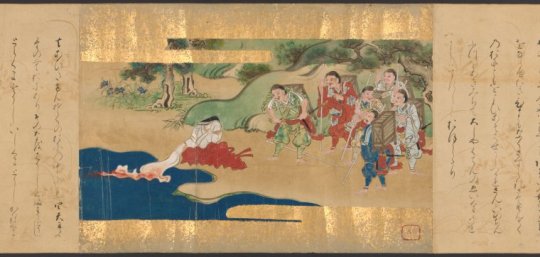
Encounter with the woman washing bloody clothes (NYPL Digital Collections)
Regardless of her age, she reveals some additional information about Shuten Dōji, though that also varies depending on the version. In some, she explains that he looks like a human during the day, but takes the form of an oni at night. His human form is specifically that of a dōji, literally “child”, but we’ll get back to the full context of this term later. In any case, I think it's safe to say the shape and size changing is where Suika'a ability came from.
In another variant, the woman warns the heroes that Shuten Dōji is enraged by Abe no Seimei’s actions, as the onymoji apparently figured out in the meanwhile how to keep the people of Kyoto safe by employing a number of shikigami (a standard part of his repertoire).
There are no further stops on the journey, and shortly after the encounter with the woman of variable age Raikō and his men enter the mountainous land of the oni. Especially in the older versions, it’s a place completely out of this world, with all four seasons occurring at once. Once they enter the fortress located there, they instantly encounter Shuten Dōji… and ask him for a place to stay for the night.

Distinctly human-like Shuten Dōji, as depicted by Yoshitoshi Tsukioka in One Hundred Ghost Stories from China and Japan (LACMA; reproduced here for educational purposes only)
Rather unexpectedly, he instantly agrees. He then tells them about his past; this largely a shorter version of the legend already discussed earlier, though with nothing predating the Mt. Hiei section mentioned. We also get a specific date for his arrival on Mt. Ōe, 849. This doesn’t last long, though, and soon he invites the protagonists to partake in a feast with him. This is obviously not a regular party, and while the individual versions can be more or less graphic, it is clear that the oni are consuing the flesh and blood of their captives.
Despite various horrific sights, Raikō maintains composure. He uses the opportunity the feast presents him with to offer Shuten Dōji the sake he received from the three (or four) deities earlier. As expected, Shuten Dōji gets drunk, and leaves to rest in his chamber.
The other oni continue to party. In some versions, some of them try to approach the protagonists by disguising themselves either as a group of courtly ladies or as a dengaku troupe, but Raikō’s glare is so intense they quickly relent. Eventually all of the oni give up on attempting to engage with the alleged ascetics and end up drunk.
That’s when the heroes decide to free their captives. These obviously include the women from Kyoto. However, as it turns out, Shuten Dōji’s rampages actually extended beyond Japan, to India and China, though only captives from the latter area actually appear. Multiple versions additionally mention that one of the prisoners was a young acolyte of the Tendai abbot Ryōgen, who was protected by assorted deities. This doesn’t really come into play in any meaningful way, though. Once everyone is freed, the heroes draw their weapons and enter Shuten Dōji’s chamber.
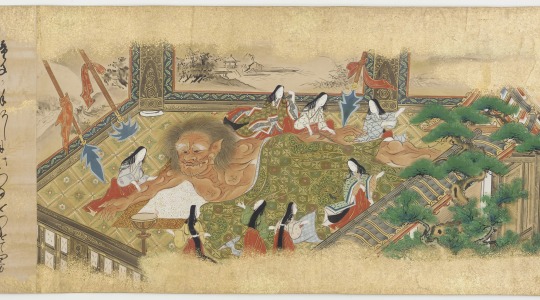
Sleeping Shuten Dōji (National Museum of Asian Art; reproduced here for educational purposes only)
The protagonists finally witness Shuten Dōji's oni form. He is five jō (around fifteen meters) tall, has fifteen eyes and five horns. His head and torso are red, his right arm is yellow, his left arm is blue, his right leg is white and his left leg is black. This might be a reference to the five elements. Alternatively, he could be described as entirely red, which might either be yet another way to reference his love of alcohol, as in the case of the shōjō, or an indication he was comparable to a “plague deity” (疫神, ekijin).
The manifestations of the deities from earlier show up again, this time to hold Shuten Dōji in place so that Raikō can strike. He cuts off his head, but to his shock it rises into the air and starts talking.

Confrontation between the heroes and the floating head of , as depicted by Yoshitsuya Utagawa (wikimedia commons)
Shuten Dōji actually mocks the heroes: “How sad, you priests! You said you do not lie. There is nothing false in the words of demons.” Needless to say, his final words are pretty directly referenced in Touhou. Oni, at the very least, claim they do not lie. Mileage of course varies, though.
ZUN is not the only author drawn to this element of the legend. It would appear that even the Japan Oni Cultural Museum has advertised itself with the words “there is nothing false in the words of demons” in the past. As noted by Noriko T. Reider, emphasizing this apparent honesty (or naivete) sometimes serves as a way to make oni sympathetic or even relatable for modern audiences.
However, it's worth noting that in the noh version, Raikō pushes back against Shuten Dōji’s words, and points out even the claim oni do not lie is a lie. He has a point, considering some versions outright establish oni capture their victims by disguising themselves as people close to them, imitating their voices. It probably also should be pointed out that in Konjaku Monogatari, oni are said to be scary precisely because they can tell apart right and wrong.
Anyway, oni ethics aside, it turns out that to kill Shuten Dōji for good, one has to gouge out his eyes. Once that is accomplished, Raikō's mission is finally complete. After killing the other oni, the protagonists take the head with them to Kyoto. Obviously, they also take the freed captives with them. The young women return to their families, and the Chinese men head for the coast to find a ship which could take them home. They promise to let the emperor (the Chinese one, for clarity; that would be Zhenzong of Song in 995) about Raikō's heroism.
In the versions where the woman washing clothes was elderly, rather than simply one of the young captives, on the way back the protagonists learn that she has passed away in the meanwhile, since her lifespan was unnaturally extended by Shuten Dōji. Once he died, so did she.
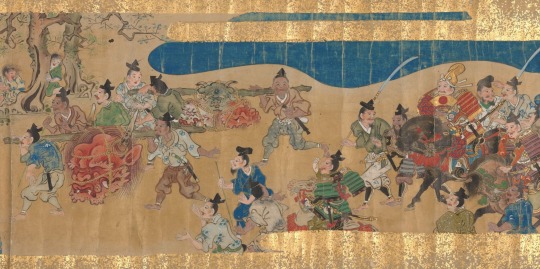
Transport of Shuten Dōji's head to Kyoto (NYPL Digital Collections)
Before the head can enter the capital, a purification ritual has been performed. Abe no Seimei thankfully knows how to do that. Thanks to him, all the relevant authorities can examine it. The emperor decides it will be best to store it in the treasure house of Uji. This location pops up in multiple legends. The severed heads of the two other equally famous malign entities, Ōtakemaru and Tamamo no Mae, were also stored there according to legends focused on them, in addition to various Buddhist relics and mundane treasures.
In an alternate version, the head never reaches the imperial court. Raikō and his retainers encounter the bodhisattva Jizou, who tells them it is too impure to be shown to the emperor, and suggests burying it. The location selected, a hill on the northwestern limits of the city, came to be known as Kubizuka (首塚), literally “head tumulus”. Shuten Dōji actually came to be enshrined there as Kubizuka Daimyōjin (首塚大明神), and in this divine guise developed an association with learning and ailments of the head.

The Kubizuka shrine in 2019 (wikimedia commons)
There is yet another variant tradition about the final fate of Shuten Dōji: after his death he became a vengeful spirit, and then turned into a tsuchigumo, just to be defeated by Raikō and his retainer Tsuna for a second time.

Raikō and Tsuna battling tsuchigumo, as depicted in Tsuchigumo no Sōshi Emaki (wikimedia commons)
Interestingly, it has been argued the tale of Shuten Dōji was at least in part based on that of the tsuchigumo Kugamimi no Mikasa (陸耳御笠), who resided on Mt. Ōe according to Tango Fudoki Zanketsu (丹後風土記残欠). The tale is not preserved fully, though, so all we know for sure other than the location is that the hero opposing him was Hikoimasu no Miko (日子坐王), a stepbrother of emperor Sujin (he is also attested in other sources). A second tsuchigumo, Hikime (匹女) is successfully defeated, but the fate of Mikasa is left unspecified in the surviving sections. This obviously makes further comparisons difficult. The topic of tsuchigumo cannot be dealt with here due to space constraints, but I promise I will return to it in a future article.
The supporting cast of Shuten Dōji
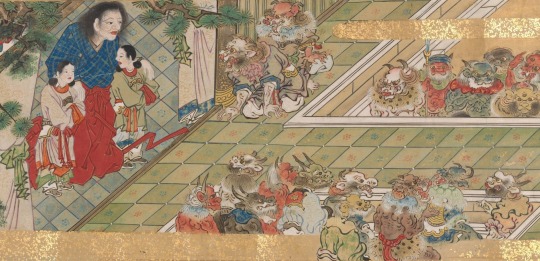
Shuten Dōji in his human form and his oni henchmen (NYPL Digital Collections)
Something that requires further discussion is the matter of the underlings of Shuten Dōji, since it is a topic directly relevant to Touhou. You might have noticed I actually avoided referencing them in any meaningful capacity in the summary of the legend. That’s because they actually do not play a major role. There also wasn’t any consistent view regarding their number or names. However, the version which came to be standard in the Edo period lists four of them - an obvious mirror of Raikō and his entourage. As a matter of fact, both groups even share the same moniker, Four Heavenly Kings.
This idea predates the Edo period, though. An earlier variant based on picture scrolls created by Kanō Motonobu already lists four servants of Shuten Dōji: Gogō, Kiriō, Ahō, and Rasetsu (yes, an oni named Rakshasa). However, two additional oni at his service are also listed, Kanakuma Dōji and Ishikuma Dōji. They are described as his personal guards, and as, well, dōji. It is clear the term is used in a literal sense here - they are said to look like “overgrown adolescents”. Two different subordinates are mentioned in another picture scroll: Kirinmugoku (麒麟無極) and Jakengokudai (邪見極大). However, they do not receive any characterization, or even physically appear in the narrative. Shuten Dōji shouts their names when he is about to die, and the very assumption that he’s referring to his oni subordinates is conjectural. The same version states that there were at least ten oni in the fortress so it’s not like it’s an implausible assumption.
The group of four oni returns in the standard Edo period version, where their names are Hoshikuma (“Star-bear”) Dōji, Kuma (“Bear”) Dōji, Torakuma (“Tiger-bear”) Dōji and Kane (“Iron”) Dōji. There’s also a fifth oni who is not a member of the group of 4, but shares the same naming pattern, Ishikuma Dōji. He actually gets a handful of lines, though they do not really provide him with much of a character beyond establishing he likes sake, that he eats humans, and that he is loyal to Shuten Dōji. Kane Dōji also gets a single line… explicitly alongside Ishikuma and multiple other nameless oni, though, and it boils down to announcing they will go down fighting because without their leader they no longer have a place to go.
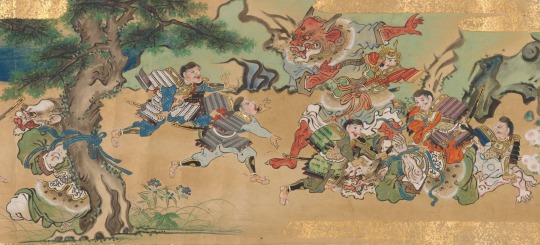
Defeat of the oni (NYPL Digital Collections)
Ibaraki Dōji: Shuten Dōji’s only equal?
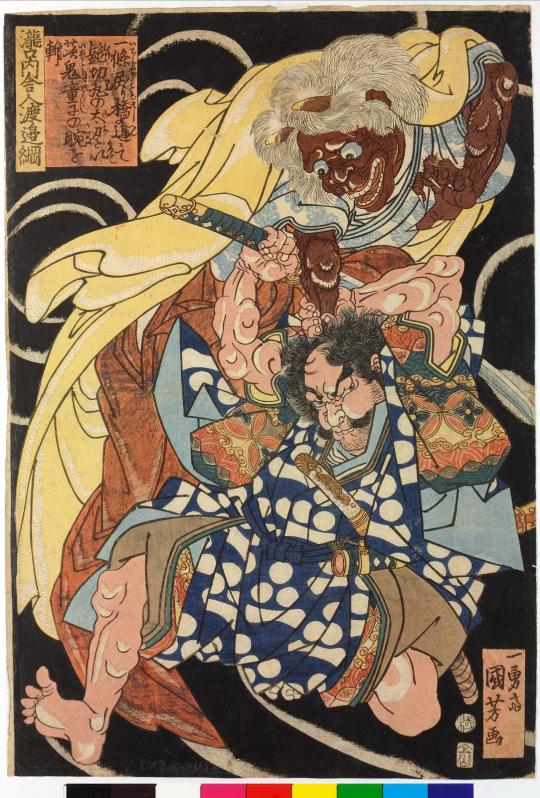
Watanabe no Tsuna battling Ibaraki Dōji (wikimedia commons)
A further unique case is that of Ibaraki Dōji, who actually acquired some fame as an individual character, and today is sometimes cited as an example of an oni equally archetypal as Shuten Dōji.
Despite being portrayed as a close associate of Shuten Dōji, Ibaraki Dōji to my best knowledge isn’t counted among the Four Heavenly Kings in any version. The character of the connection is evidently more nebulous. I know an assertion that a tradition presenting Ibaraki Dōji as Shuten Dōji’s wife is attested is repeated as fact on wikipedia and various at least semi-credible websites, but there is never a citation provided, and no version of the narrative covered in articles and monographs I have access to includes such an element. I am not claiming it is impossible, though I do feel the fact it doesn’t come up in any paper or monograph discussing either figure I have access to doesn’t mention to might indicate it’s either a recent reinterpretation or a very obscure local variant. Note this is not meant to be an argument against any Touhou ships.
What I can say with certainty is that Ibaraki Dōji’s gender is actually a matter of occasional academic dispute. In the versions of the basic Shuten Dōji narrative which mention this oni, he is pretty firmly male. However, he is said to be capable of taking the form of a woman. Noriko T. Reider argues that on this basis it can be effectively assumed that at the very least this specific oni can be considered genderless or capable of freely changing their gender, though she tentatively extrapolates this ability to oni in general.
While Ibaraki Dōji’s gender changing adventure is technically its own legend, a reference to it was incorporated into the basic Edo period version of the Shuten Dōji narrative. During the feast, the latter mentions in passing that the former, his trusted ally, lost his arm in a fight with Watanabe no Tsuna during one of their Kyoto raids, after failing to abduct him while disguised as a woman. He clarifies that the arm was later recovered, but not particularly many details are provided.
The rivalry between Tsuna and Ibaraki Dōji subsequently comes into play after Shuten Dōji’s death, when the protagonists are about to exterminate the other oni. Ibaraki charges him and they two fight without a clear winner for a while, until Raikō intervenes and kills the oni. I would argue that despite him being responsible for dealing the killing blow, it is Tsuna who should be considered Ibaraki’s nemesis, though. Interestingly, at some point ZUN considered featuring a character based on him in Wild and Horned Hermit (source). That obviously did not come to pass, though.
Tsuna already fights an oni in Heike Tsuruginomaki, and many other variants of the story were written subsequently, with the noh play Rashōmon being the most famous. Curiously, the oldest version makes no reference to Shuten Dōji, and the oni actually resides on Mt. Atago, but by the Edo period the two were regarded as allies operating from Mt. Ōe.
The details are otherwise generally similar across all of the sources. Raikō sends Tsuna on an errand. He encounters a woman on the Modoribashi Bridge in Kyoto, but as soon as he offers to take her with him she turns into an oni. Thinking quickly, he cuts off the creature’s arm, which is enough to make them flee. He keeps the severed limb as a trophy. Some time later, he is visited by an old woman who he assumes is his aunt... but who turns out to be the same oni, who uses a brief moment of confusion to recover the arm and fly away.
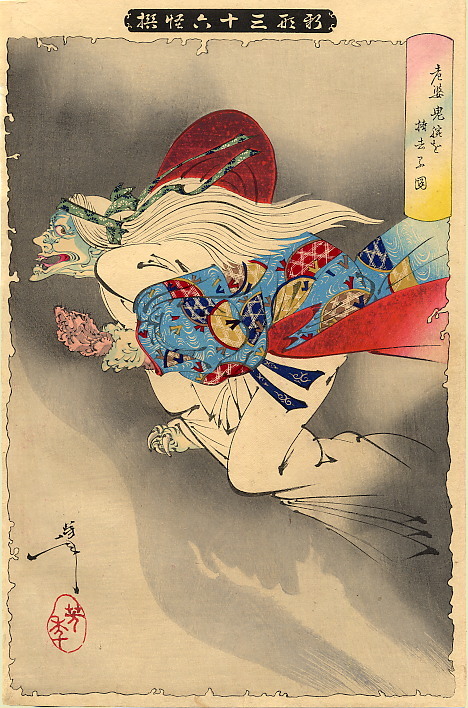
Transformed Ibaraki Dōji, as depicted by Tsukioka Yoshitoshi (wikimedia commons)
The legend of Ibaraki Dōji was evidently reasonably popular in the Edo period, and could even be utilized to comedic ends. One example is an Edo period satirical pamphlet, Thousand Arms of Goddess, Julienned: The Secret Recipe of Our Handmade Soup Stock, written by Shiba Zenkō and illustrated by Kitao Masanobu. Here the one-armed Ibaraki Dōji is one of the figures interested in leasing one of the now detached additional arms of the Thousand-Armed Kannon, who has apparently fallen in dire straits (“business slumps are inevitable, even for a Buddha”, comments the narrator, alluding to the financial conditions of the 1780s). As we learn, after making a purchase Ibaraki is disappointed by the lack of hair, and promptly hires a craftsman to add it:

Original translation by Adam L. Kern; reproduced here for educational purposes only. I am not responsible for the typesetting.
In my recent Ten Desires article I’ve already discussed the oni of Rashomon as a character in legends about Yoshika no Miyako, which I won’t repeat here. It will suffice to say that this conflation effectively made Ibaraki a penchant for poetry and fine arts, and that it indirectly put him in the proximity of the pursuit of immortality. Whether this is why ZUN made Ibaraki’s counterpart a wannabe immortal (“hermit”) is difficult to ascertain, but it does not strike me as impossible.
The oni of Rashomon actually appears in at least one more legend which similarly portrays him as an enthusiast of the arts, though to my best knowledge this one never came to be reassigned to Ibaraki Dōji. It is centered on a famous biwa player, Minamoto no Hiromasa, who has to resolve the case of mysterious theft of an instrument from the imperial palace. As you can expect, it is revealed to specifically be an exceptional biwa, which bears the name Genjō. Hiromasa surveys the city in hopes of finding it, and eventually hears its distinct tones while passing near the Rashomon gate. He quickly realizes an oni is playing it. He politely asks if he can have it back, since it’s a treasure of the imperial court… and the oni eagerly obeys, thus bringing the story to a happy end. However, we are told Genjō acquired supernatural qualities in the aftermath of the theft, and only played when it felt like it, as if it was a living being.
There is a variant which reveals that the oni of Rashomon was in fact the ghost of Genjō’s original maker, a craftsman from India. In this version, Abe no Seimei has to intervene to recover it, and the oni only agrees to return it after being promised a night with a woman he fell in love with who resembles his deceased wife. There is no happy ending here, though, as the woman’s brother convinces her she needs to kill the oni. She fails, and meets such a fate herself instead. It seems that the reader’s sympathy is actually supposed to be with the oni in this case.
Conclusions, or why you should make your own Deva of the Mountain

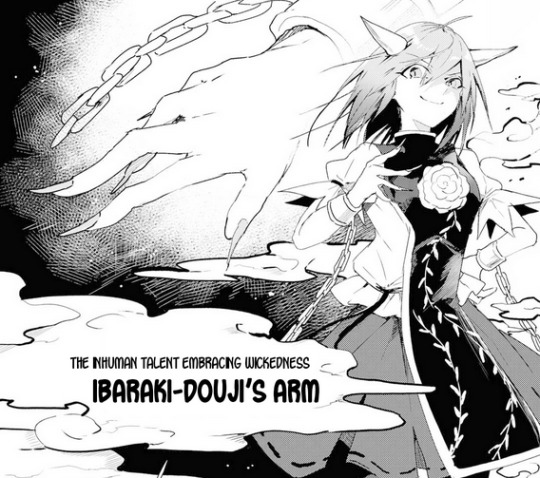
Obviously, there is nothing novel or clever about stating that the two figures this article is focused on, Shuten Dōji and Ibaraki Dōji, correspond to Suika and Kasen respectively. You can learn that from the official media itself, after all. Funnily enough, it seems this might have been even more blunt, judging from unused ideas for referencing the legend to an even greater degree in WaHH, with the defeat at Mt. Ōe as the explanation why oni reside… well, elsewhere (source). Granted, it would also be a disservice to ZUN to say he only created anime girl versions of the classic oni. He effectively created his own versions of both Shuten and Ibaraki - for every similarity between the irl background I’ve described and Touhou, there is also something brand new. That is part of what makes Touhou compelling, I would argue.
Naturally, the fact that the group Kasen and Suika belong to is referred to as the Four Devas of the Mountain shows clear inspiration from the Edo period version of the original legends. However, Suika and Kasen are counted among the four, which is obviously an innovation. Additionally, while Yuugi is naturally named after Hoshikuma Dōji, who you were able to meet earlier, save for the name she is effectively a fully original character. Her ability references the Analects of Confucius, rather than anything directly tied to Shuten Dōji. And, on top of that in all honesty, she has more character than any of the additional oni appearing in the real legends. ZUN, as far as I am concerned, created a more than worthy addition to the classics.
What about the much discussed fourth deva? I think it’s safe to say that in the light of the discussed material there simply isn’t a single most plausible option. As I stressed already, there’s no consistent group of oni appearing alongside Shuten Dōji, and it cannot be said that the Edo period version is clearly what should be treated as true in Touhou. ZUN picked what he liked from many versions.
For what it’s worth, so far all of the oni forming the Four Devas are based on those who share the moniker of dōji, so that’s the closest we have to a theme. As I already said earlier, this term can be simply translated as “child” (or “lad”, though I think a gender neutral option is more apt since we are talking about Touhou here, ultimately). However, it has a more specific meaning when applied to supernatural beings. In this context it refers to a category of ambiguous figures characterized by “vitality, (...) hubris, and (...) unpredictability”, as well as fondness of violence, as summarized by Bernard Faure. Shuten Dōji, and by extension his underlings, are obviously the dōji par excellence. However, the term could also be applied to benevolent, or outright divine beings. That, however, goes beyond the scope of this article.
I personally think despite the possible dōji theme the fourth slot will never be filled, ultimately. ZUN likes leaving gaps in established groups - there are types of tengu which were a part of the background for well over a decade, for instance. I think these are left as paths to make ocs with an instant excuse to interact with canon characters. Despite ZUN’s generally pro-fanwork stance I do not think I’ve ever seen anyone make this point.
As far as I am concerned, the conclusion is clear: it’s entirely fair game to invent characters to fill the empty spot. There’s even a solid case to be made for reinventing oni from other legends as members of the Four Devas - remember that much of Ibaraki Dōji’s character was borrowed from a nameless oni from a legend about the Rashomon gate, as I discussed last month.
Bibliography
Bernard Faure, Rage and Ravage (Gods of Medieval Japan vol. 3)
Michael Daniel Foster, The Book of Yokai. Mysterious Creatures of Japanese Folklore
Adam L. Kern, Thousand Arms of Goddess, Julienned: The Secret Recipe of Our Handmade Soup Stock, written by Shiba Zenkō and illustrated by Kitao Masanobu (translation and commentary), in: An Edo Anthology: Literature from Japan’s Mega-City, 1750–1850
Keller Kimbrough and Haruo Shirane (eds.), Monsters, Animals, and Other Worlds. A Collection of Short Medieval Japanese Tales
Irene H. Lin, The Ideology of Imagination: The Tale of Shuten Dōji as a Kenmon Discourse
Michelle Osterfeld Li, Human of the Heart: Pitiful Oni in Medieval Japan in: The Ashgate Research Companion to Monsters and the Monstrous
Noriko T. Reider, Shuten Dōji: "Drunken Demon"
Idem, Japanese Demon Lore
Idem, Seven Demon Stories from Medieval Japan
also check out the scans of an amazing Shuten Dōji picture scroll from the NYPL collection here!
143 notes
·
View notes
Text


The Higuri Regalia - proud allies of Abbiocco Fine Dining - is pleased to announce the return of: The Mythril Showcase!
As a refresher to those uninitiated: this fashion show was created during the twilight days of Menphina Madness to provide the frequenters of the Etheirys Blitzball League an opportunity to show off their acumen in style outside of the Blitzsphere. Since then, Thiji Higuri - the merchant-lord and fashion nabob himself - has tested the skill and daring of haute couture hopefuls through various themes.
This time, The Regalia will be teaming up with Abbiocco Fine Dining ( https://abbiocco.carrd.co/ ) to provide an exclusive venue that will open with a sneak-peek of the upcoming clothing line! Select outfits from this arcane collection will be showcased only during this night, and will not be seen or sold anywhere else until the official release of the line. So don't miss out!
(Additional information will be provided closer to the event date!)
With two successful shows now under the Regalia's belt, the deciding of the next theme was opened to the public via poll to give proper closure to this turn; now the results have finally arrived. The theme for the third Mythril Showcase will be: "Kingdoms of the Far East." This inspiration takes from the popularized culture and history of Othard, namely during its warring periods in Hydaelyn's timeline. (TRANSLATION: this cosplay contest is based off the Dynasty Warriors/Samurai Warriors/Warriors Orochi series)
Those who wish to participate are welcome, and will be handsomely rewarded with a glamour weapon of their choosing for their efforts. This time, however, there is a twist: as there were warring factions during ancient times, so, too, will there be specific glamour weapons tailored to them! They are detailed below:
Wei: Knights of the Round/Susano
Wu: Rubellux/Tsukuyomi
Shu: Smaragdine/Shinryu
Jin: Fae's Crown
Other: Warring Triad (Sephirot/Sophia/Zurvan)
Samurai: Four Lords (Seiryu/Suzaku/Byakko)
Orochi: Hades/Seeing Horde
(NOTE: If the faction of the character you are portraying as does not contain your desired glamour weapon, you are allowed to choose from another category. It is advised you do your research beforehand to prevent confusion.)
The top four winners will receive far more greater prizes:
4th Place Winner: An assortment of Pixie, Archangel, and Statice's Wings!
3rd Place Winner: An Island Adenium Whistle!
2nd Place Winner: A Shishioji Flute!
1st Place Winner: A Voucher of the Higuri!

(Translation: a commission of your character in the desired outfit will be made!)
(Note: Additional prizes may also be given depending on the quantity of participants!)
The event will take place on Friday, December 22nd at 7PM EST (Doors open an hour prior) - the day of the Winter Solstice! The location: Abbiocco Fine Dining in the Goblet, Ward 14, Plot 35 (Diabolos World). Whether you wish to spectate, or show off your own Power in Beauty, all are welcome to attend!
Contestants will be judged based on a variety of categories on a 1-to-10 scale. For the sake of fairness, these criteria will be made known to all. They are as follows:
-Emulation: Cosplaying - as accurately as possible - a certain character from a particular source of media (game/show/movie, etc.)
-Adherence: Remaining within the scope of the theme.
-Embellishment: Complimenting your outfit with accessories and other small details.
-Stage Presence: Your ability to “strut your stuff” via actions or emotes.
-Reception: How well you command the audience’s excitement and attention.
*-Innovation: Any additional nuances to your entry (using minions, reciting lines, etc.) for extra points.
(You may request to sign-up to compete by utilizing this form: https://forms.gle/Xty9CFEdD3aVq3wWA. Sign-ups will conclude prior to the contest’s commencement - 30 minutes prior to showtime.)
#thiji higuri#higuri regalia#ffxiv#high fashion#fashion#pib catalogue#ffxiv rp#haute couture#mythril showcase#fashion show#cosplay contest#ffxiv a realm reborn#lalafell#abbiocco's#dynasty warriors#samurai warriors#warriors orochi#shin sangoku musou#sengoku musou#far east#Hingashi#ffxiv doma
49 notes
·
View notes
Note
I have a pretty good inkling who your number ones are so can I ask for you for your top few fire emblem characters?
Always! I'm just gonna list off a few I really like and if you want more details on any of them I can go into it! Awakening was my first game and I've spent the majority of my time with the post-Awakening titles so that's gonna be the bulk of the list
For Awakening I initially liked Chrom, Robin, Henry, Lon'qu, Inigo, Noire, and Severa, and Lucina a lot. Cherche has also grown on me a lot over the years and not just because she's hot and can crush me like a bug and she was vital to my 2017 FEH team I swear
For Fates I like all of the Royal siblings, but Takumi, Leo, and Sakura are probably my top three. If I had to order them it'd probably be Takumi > Leo > Sakura > Xander = Camilla > Hinoka = Elise > Ryoma. Other than them Orochi, Rinkah, Charlotte (CQ wife), Reina (BR wife), Azura, and Nyx are all characters I enjoy. Honorable mentions to the four royal second gen kids as well as Selkie and Velouria!
SoV I don't hold a lot of strong opinions on since I only played it once back in 2017, but I remember really liking Kliff
For 3H all of the Blue Lions are my darlings, but I also like Dorothea, Petra, Manuela, Seteth, Rhea, Shamir and Catherine. Honorable mention to Cyril. I wrote him off initially but he's genuinely hilarious and savage when the writers let him talk about stuff other than Rhea
For Engage I honestly don't think there's a member of the cast I don't like, but Alfred, Celine, Alcryst, and Ivy (wife) are probably my top four. I really like all of the royals though, and additional shout outs to Rosado, Saphir, Merrin, and Chloe
Of the pre-Awakening characters I'd say Tibarn, the Heron sibs, Naesala, and Nailah are the stand outs from PoR/RD. Ike and Elincia are up there too as far as FE lords go. I recently beat Sacred Stones and there it's probably the twins, Innes, Tana, Seth, Cormag, with a little Ross just because mine ended up being a monster
I'm withholding adding characters from Binding Blade, Blazing Blade, Shadow Dragon, Genealogy, or Thracia to the list just becaues I haven't played those ones all the way through yet. Though I do have a soft spot for Caeda entirely because of FEH
I don't know if I'd be able to put them into a coherent top five all together, I'd probably have to go by game tbh, but this post is already pretty long so I'll refrain for now lol
12 notes
·
View notes
Text
Out Of Context OPM Day #52
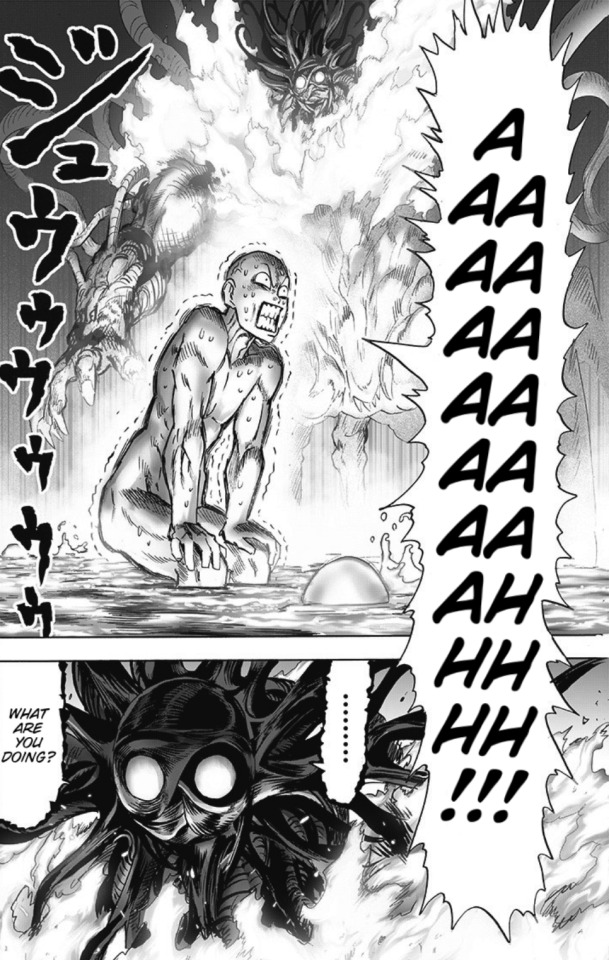
#one punch man#opm#out of context opm#out of context one punch man#lord orochi#saitama#me too orochi
58 notes
·
View notes
Note
Update on how many unique characters you’ve received?
As usual, super long list, so here we go!
These characters have two+ (2+) submissions, and are likely to be included.
Vriska Serkat
Eridan Ampora
Shiver
Kokichi Ouma
Haiji Towa
Minoru Mineta
Simon
Boston
Bill Cipher
John Gaius
Regal Farseer
Ayin
Kylo Ren
Mal
Jurgen Leitner
Merlin
Darkstalker
Kyubey
Ty Betteridge
Sasuke Uchiha
Dazai Osamu
Glenn Quagmire
Rose Quartz
Makima
c!Dream
Izzy Hands
Akio Ohtori
Katsuki Bakugo
Bramblestar
Michael
Don Quixote Doflamingo
Elias Bouchard/Jonah Magnus
Ansem the Wise
Kusaka Masato
Azula
The Metatron
Evan Hansen
Stella Goetia
Pierce Hawthorne
Le’garde
Lance Dubois
Santa Claus
Meenah Peixes / Her Imperious Condescension
Greg Heffley
Tony Stark
Donald Trump
Jace Herondale / Wayland / Lightwood / Morgenstern
Teddy / Kuma
Mr. Bungee
Julia Mazzone
Sentinel Prime
William Afton
Cullen Rutherford
Shou Tucker
Junko Enoshima
Ardyn Izunia
Sosuke Aizen
Happosai
Simon Laurent
Caillou
Ōchi Fukuchi
Jin Guanyao
Micah Bell
Cici
These characters have been submitted only once, and have a lower chance of being accepted.
Michael Scott
Detective Saracusa
Paul Von Oberstein
JJ
Box
Damian Wayne
Cersei Iannister
Shredder
Splinter
John ‘Jack’ Seward
Akane
Abyss Sibling
House
Nickel
Julie-Sue
Tim Drake
Xisuma
Dr. John ‘Jack’ Seward
Hisoka
Gra’ha Tia
Elias Ainsworth
Trishna
Erlina and Brugaves
Five Pebbles
The Entirety Of Homestuck
Willy Stampler
Miguel O’Hara
Medusa Gorgon
Gamzee Makara
Rohan Kishibe
Teruhashi Makoto
Gordon Blackwall
Rebecca Costwolds
Dio
Anakin Skywalker
Sigma Kilm
Caesar Clown
Shiki Tohno/Nanaya
Mori Ougai
Asuka
Marlon
Pencil
Touichiro Suzuki
Alexander Hamilton
Georg Weissmann
Dean Winchester
The Operator
Kromer
Scrappy Doo
Foreman Oyun
The Eleventh Doctor
Any Character From Welcome to Nightvale
Will Shuester
Marie
Silver Spoon
Jayne Cobb
Byakuya Togami
Prince Louis
Coco
Princess Daisy
Light Yagami
The Pale King
Yoshiharu Hisomu
Himiko Toga
Sebastian Mechaelias
Mystery Hunter (Jeremiah Hartley)
Muzan Kibutsuji
Clara Oswald
Ranpo Edogawa (Beast)
Heath cliff
Inspector Tobias Greyson
Roland
Huey Emmerich
Tom Wambsgans
Yuri Briar
Jacopo Bearzatti
Quiche
Alastor
Meredith Rodney McKay
Every Single Country In 1993
Cicero
Val Velocity
Jiren
Noor Pradesh
Blackbeard
Kristoph Gavin
Morris
Dan Moroboshi
Muu Kusunoki
Julia
Shen Jiu
April O’Neil (2012)
Johnny
Adam
Ronaldo
Makoto Itou
Ianthe Tridentarius
Disembodied Voice
Viren
Spamton
George Wickham
Floch
The New Ninja
Sakazuki Akainu
Petyr Baelish / Littlefinger
Childe
Wen Chao
Stormcaller
Chibiusa
Ashfur
Dimitri Alexandre Blaiddyd
James T. Kirk
Billy
Mikan Tsumuki
Teruteru
Orochi
Millions Knives
The Mage
Lotor
Otto Apocalypse
Sanji
Woodes Rogers
Zeke Jaeger
Dean Venture
Absalom
Aloise Trancey
Cynte
Akito Sohma
Pierre
Monokubs (Except Monodam)
Edelgard
Chrollo Lucifer
Chloe Bourgeois
Zhou Zishu
Wanderer/Scaramouche
Elon Musk
Il Dottore
Goeffry St. John
Nikola Tesla
Louie
Ogai Mori
Astarion
Mary Keay
Dr. Henry Miller
Booker
Voice In The Calm Ad On Spotify
Akechi Goro
Victor Frankenstein
Five
Riley Finn
Anyone From The Locked Tomb
Elias Ainsworth
Nefera DeNile
Angel Dust
Blitzo Buckzo
The Once-Ler
Moash
Zenos Galvus
Marvin Falsettos
Solf J. Kimblee
Father / Dwarf In The Glass
Henry the Eighth
Aranea Serkat
Bro-Strider
Caliborn / Lord English
Feferi Peixes
Skizzleman
Black Pete
Narumi
Cozy Glow
Holly Blue Agate
Every Genshin Impact Character Ever
Drew
Dio (Zero Escape)
Matou Shinji
Chris McClain
Thistleclaw
Rumpelstiltskin
Ruruka Ando
Sheldon Cooper
Buck Cluck
Valens Van Varro
Verstael Besithia
Kevin
France (Hetalia)
Tumblr Staff
Slayer
Volgin
Yumichika Ayasegawa
Roshi
Chibiusa
Akio Himemiya
Ali Lectric
Rafe Cameron
Raven Queen
Duke
Sandy
Everyone In Romeo And Juliet
Bella Swan
Haiji Senri
Tsumugi Aoba
Vivienne Medranno’s Impsona
Buzz McCallister
Eugene Coli
Live Action Buggy
Aizen Sosuke
Kyouichi Saionji
Ibara Saegusa
Yu Ziyuan
Mahiru Koizumi
The Little Palace Mistress
Eichi Tenshouin
The Old Palace Master
Rafal
Jonah Magnus
Queen Scarlet
Nanami Kiryuu
Hiyoko Saionji
God
Roger
Judo
Ken
Steven Universe
JD
#mod speaks#not a poll#most hated blorbo bracket#ask answered#I would cry#trying to tag all these characters
18 notes
·
View notes
Text
Tales Unknown - The Main Cast
"This is the story of youkais...a story of us and our memories..."
Warrior-like youkais, the Youkai Keepers, are groups that watches over both worlds; humans and youkais (including that hidden world they know of). Over decades, they have many life-changing events. Forming strong bonds and connection. Creating unforgettable memories...
Now in the era of shadow and lights, the Youkai Keepers are now facing huge threats to both worlds. At the same time however, they're not aware...of the greater secrets they have
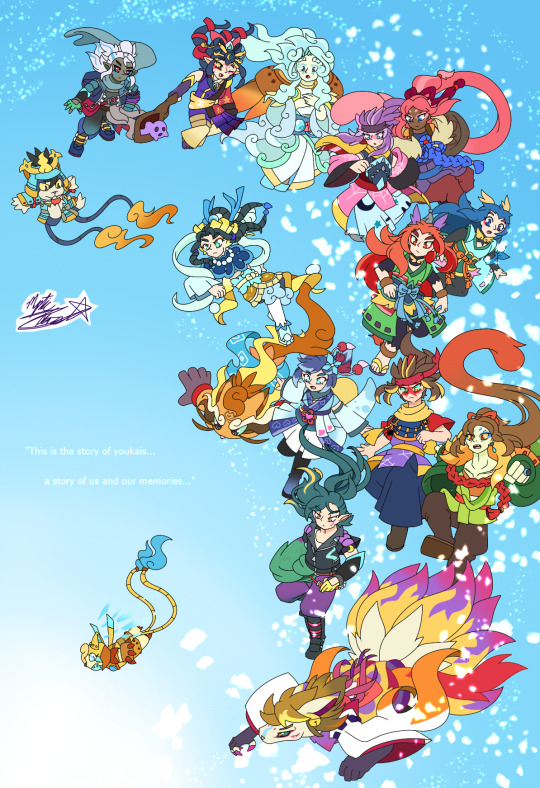
Mini squad/groups of the Youkai Keepers: (all 4 are in WIP)
The Amazing Four (WIP)
The Band (WIP)
The Blossom Fighters (WIP)
The Flashing Fury (WIP)
#youkai watch au#yo kai watch au#orochi#venoct#kyubi#arachnus#tsuchigumo#toadal dude#ogama#dragon lord#azure dragon#jorogumo#oyamori#blizzaria#fubuki hime#everfore#smogmella#mermadonna#kage orochi#shadow venoct#komiger#goldenyan#shogunyan#bushinyan#that is alot tags omg lol
1 note
·
View note
Text
Orochi random NSFW headcanons
I decided to please you a little hehe
The only way to get him to do something is to play on his ego. Orochi is very fond of himself, so a snide remark on such a delicate subject may hurt him, although he will not give it away
Serpent Lord doesn't mind sex, but he needs a good reason to get into bed with someone. And Orochi is quite selective about who he wants to have sex with
Orochi likes the feel of sex and is willing to have it for a long time, but this guy would like to have someone for permanent sex, not just one-night stands
The desire to have a regular partner comes from his desire for s/o to match him well and because he will just be inclined to have sex because s/o are around lol
Orochi likes to have sex in the streams of the aether
Takes an exclusively dominant position
He will always cum inside, regardless of his partner's opinion
Loves to receive rather than give
Orochi likes water sex
He's quite talkative during sex
Orochi likes it when they cum right on his dick
He likes to tease s/o until they beg for mercy
Serpent Lord loves the feel of wet, just cumming hole when he takes them
Orochi will not kiss his partner until he becomes attached to them (a rather long process for him), but he will leave many hickeys and bites
This guy has incredibly strong stamina. If he is in the mood, s/o will have to endure his desire
Evil god is very curious, so he is willing to try a lot of things in bed. And yes, Orochi loves anything related to BDSM
Orochi wonders how much s/o can take because in the end, from his touch to his cum inside his partner's holes, it will all defile their body and destroy them
He likes it when his s/o swallows his cock deep. And it especially excites him when they swallow his cum
Serpent Lord likes beautiful positions where his cock can enter them completely
Orochi loves it when they spread their legs wide, when he's about to cum, so that his cock goes in as deep as possible and their hole takes every last drop
He especially likes to keep fucking them when s/o start trembling violently from overstimulation
27 notes
·
View notes
Note
Hey-ya! I saw that your requests are open. Can i perhaps request Date Masamune, Azai Nagamasa, and Fūma Kotarō with an s/o who got hurt while trying to protect them? Thank you!
Ah, my first request, how delightful! You asked and you shall receive, dear Anon! Now, despite being someone who writes so much, I have somewhat of a terrible reading comprehension, so I hope you meant it in the way that the s/o was the one doing the protecting (maybe it's unreasonable, but my brain also interpreted the other way and now I'm unsure, oof). That's the way I wrote it, but of course I'll gladly write it the other way around in the future, or even make a part 2 of this with other characters! More author's notes at the end. Happy reading!
⛊ His Shield - SB Imagines ⛊
(Masamune, Nagamasa, Kotarō)
You're no fighter, and yet you sneaked onto the battlefield nonetheless, wracked with worry for your beloved. You know you shouldn't be here, but how can you just sit around in safety while he risks your life for you and his clan? The idea that you'll just wait there anxiously and he may or may not come back alive... it's too much. You find a good spot where you can see most of the battlefield while still remaining hidden. Everything goes well for a while, until you see an enemy wielding a tanegashima aiming at the love of your life, without him noticing. Without thinking, you rush into the fray, and make it just in time to jump in front of the bullet...
⛊ Masamune ⛊
When Masamune hears the gunshot, his head instantly snaps back in that direction. He expects to see one of his men and is already ready to give new orders to make sure the party doesn't stop because of a single wounded. But instead, he sees you. He's stunned.
Your eyes are wide as you slowly fall on your knees, clutching the wound with your hand. You're bleeding, and badly. At least the pain is not such a problem, as you are in a state of shock, barely even comprehending what's happening. The One-Eyed Dragon lets out a low, frustrated grunt, struggling to believe what he's seeing. But he's a leader, and knows he can't just stand there. So he quickly starts barking out orders, making sure your position is well-defended. He also doesn't hesitate to order Kojūrō to quickly carry you to safety. His loyal eye is reluctant to leave his lord's side, but any potential protests are quickly shut down. Masamune is seeing red, and before anyone can say anything else, he's already tearing through the enemy with all of his six claws. You were supposed to stay home, sure. You shouldn't have come here, so getting hurt is technically your own fault in his eyes... but he quickly put two and two together and knows you most likely saved his life.
He cares about you too much to not be absolutely furious when someone hurts you. He already caused many a scene when someone even said something bad about you, so this is serious. His party mood is long gone, and the Dragon is ready to unleash worse death and destruction than Orochi himself. For you. He would do anything to take revenge on those who have wronged you. He doesn't forget so easily.
Kojūrō takes you back to safety and it's clear that even if he wishes to join his lord on the battlefield, he will gladly stay with you and protect you on his orders. You are his lord's greatest treasure, and so he will make sure you are safe. He even reassures you a few times when you panic in your somewhat-delirious state. You lost a lot of blood, but the medics you were brought to made sure the bleeding got stopped.
Eventually, the battle ends and the Dragon of Ōshū comes back. There's blood all over his armor, face and clothes. But judging by his calm, measured expression, it's clear none of it is his. Without a word, he kneels down beside you, and once he's sure it's fine, he gently pulls you into an embrace, careful not to cause you unnecessary pain. He runs his bloodied fingers through your hair, trying to soothe you, relieved that you're still alive. And you feel relieved too. You're both safe again, and most importantly, you're together. You've never been as happy to see that piercing eye of his as you are now.
"What you did was really stupid... but also cool."
The last word rolls off his tongue as he speaks that strange foreign language again and he rests his chin on the top of your head. His expression is a mix of frustration and that comforting, almost arrogant nonchalance you know him for.
"If you're so desperate to join the party, then at least learn how to fight and wear some armor. You know where I keep my spares," he then huffs, but it's clear he's not truly scolding you or playing down your bravery, it seems more like an invitation than anything. "Can't have you embarassing me like that again, you see?"
His expression turns into a somewhat playful grin when you smile and nod, before he plants a kiss on your forehead. He could never really be mad at you. But losing you... it terrifies him.
For what is a dragon without his star to guide him in the night sky?
⛊ Nagamasa ⛊
Nagamasa feels like his heart stopped working when he turns towards the sound of a gunshot and sees you fall to the ground like a sack of rice. Like always, he was just focused on fighting for justice and leading his men to victory, tunnel vision obscuring most of the things around him. But all it takes is one distraction, and everything crumbles before his eyes. And oh, is you getting wounded a distraction.
After a moment of shock, he finally rushes to your side, yelling for his men to protect you both and to not stop fighting. He sounds angry, though you are unable to tell if he's more mad at you or the attacker. Considering that he can be a rather volatile personality, your guess is good as anyone's. And in his head, he's absolutely furious. He really, really wants to yell at you- for not listening to him and not staying home. That slowly turns into anger at how you most likely thought your life was somehow worth less than his to even begin thinking about saving him. He knew what he was doing, he was ready for death in pursuit of justice! And yet, you, someone who doesn't even know how to wield a blade properly, just saved him so selflessly, and... no. The more he stares at your now tear-stained face, the more he realizes how much of that anger is fear in reality. Fear that you'll die and he will be powerless to stop it. Who else could he hold each night as he sleeps, who else could he love? Who would soothe his pains after he comes home, weary from battle? No one. There's no one else but you.
He takes you into his arms, his grip firm yet gentle as he runs with you to the sidelines. He feels like he's failing his men, but you are his priority right now. The world seems to fade around you both as time keeps ticking. But luckily, he gets you to safety and his men start taking care of your wounds. He's there the whole time, holding your hand as he anxiously watches the battle and barks out an order or two. But he knows you need him, and so he stays there the rest of the battle, which the Azai army luckily ends up winning. His anger slowly subsides, and the only part that remains is a desire to take revenge. That can wait, though.
For now, you need your gallant hero to take care of you.
⛊ Kotarō ⛊
Everything was going incredibly well for him. After all, why wouldn't it? Kotarō was the best of the best. Those who saw him didn't usually get to live for long, unless they hired him. The very definition of a shadow, just a thousand times more deadly. He had everything carefully planned out, and he knew that he could count on his insane reflex speed and well-trained senses to drag him out of trouble if something unexpected happened.
But there was one variable he never really counted on; you.
And it wasn't the first time. That's what drew him to you in the first place- you were one of the few who managed to surprise him. But those surprises were sweet in nature. Not... not this one. He knew about the attacker, of course, but he figured he'd take care of him right after he finishes gutting another enemy soldier like a fish. But you jumped in, thinking he could die.
You put your life on the line for him.
Everything around him seems to happen in slow-motion, even though he hesitates for barely even a second before taking you into his arms and disappearing with you to safety in a puff of smoke and feathers. He feels something... unfamiliar, long forgotten. Worry. And perhaps even a sliver of empathy. That honestly sends him into a spiral of doubt, even if he knows he can help you.
He's a ninja, after all. He forsook his humanity the moment he began training, if he even had any before. Emotions are but a distraction. He needs to be fully at peace through the bloodshed, no matter how many screams he hears or how much more his weapons get stained with crimson. An attached ninja is a bad ninja, everyone in his profession knows that. Despite you two being in a relationship, he considered it more of a courtesy and kept his distance, since you wouldn't be denied and kept finding him no matter how well he disguised himself.
But now, once you're further off, safe in the deepest part of the woods and he gently sets you down on the soft moss... it's like something is tugging at his heartstrings. You let out a sob, thinking you're going to die and reach out your bloodied hand towards him. You jumped in front of that bullet for him. A ninja who never even smiled at you, who never spoke a word to you and seemed to merely tolerate your presence. You cared. And by the kami, he wants more of that sudden warm feeling spreading all across his chest.
Kotarō gently takes your hand in his, and decides that it's now or never for him. His other hand carefully slides to the back of his mask...
...and he lets it fall down to the ground.
His face is quite beautiful, a bit older than you thought it would be. There's scars all around his eyes. And oh, those eyes. Dark scleras and white irises, as if someone flipped their color scheme on its head. They don't look human at all, and yet, there is a sadness in them that you can't help but get lost in. Your own eyes widen, and you completely forget about everything else, even your tears seem to dry in an instant. He showed you something almost no one else as seen... or maybe even no one. He sees your trust and wants to repay it in kind.
His face is as expressionless as ever, but you catch his lips move. Maybe it's just the wind, but you swear you can hear a quiet voice come out of his throat as he mouths those words.
"...forgive me. I'll do better. I am grateful."
And he will start by fixing you up and carrying you home.
---
Whew, it's finally here! I'm so, so sorry for the delay Anon, I promise I didn't forget about you! Before Christmas, I had to quickly write a fairly long story for my English class (which I also set in the Sengoku period, funnily enough). While it was my pride and joy, I was already on the verge of a burnout, so I had to recharge! Aaand after that it was a mix of writer's block and procrastion. I'm kind of sick again at the moment, so I decided to comfort myself with finally finishing this! (*_ _)人
I really enjoyed writing about all three (even though our dear Nagamasa-sama has a shorter entry)! And I'm also glad I got to use Kotarō's supposed legendary heritage. Some stories about him say he was partly oni and had inverted eyes, and considering his upper face is covered instead of the lower one, I saw an opportunity!
I hope you enjoyed reading, requests will remain open!
And as I always say...

Have an amazing day!
#sengoku basara#senbasa#senbasa fanfic#senbasa imagines#kotaro fuma#fuma kotaro#azai nagamasa#date masamune#masamune date#wish a strong daimyo held me in his arms rn#i am but a sick peasant but it would be great
8 notes
·
View notes
Note
Hey, since Kur in "our" universe looks like a giant, iridescent, black serpent with a mane of flaming feathers and antlers (amazing design you came up with, btw), and since the Monday universe takes the normal character designs and skews it a bit to the left (Monday-Fisk has horns, Monday-Zak had his hair colors swapped, etc), what would your Monday-Kur look like?
Actually, I believe Monday!Kur would be a jaguar!
The Smoke Mirror is based on the Aztec myth of the 5 suns, which states that the world has been created and destroyed four times already. Each world is defined by which god acted as the sun; the first sun was Tetzcatlipoca, who - maybe because he lost his leg in an earlier myth - did kind of a crappy job. His sun was dim and black.(We know it’s specifically this myth because the game is “beasts of the fifth sun”)
The Smoke Mirror in the show is explicitly found in a temple dedicated to Tetzcatlipoca, and furthermore, one of Tetz'z epithets was The Smoking Mirror, as mirrors in Aztec times were made of obsidian, which is one of the things associated with Tetz. FURTHERfurthermore, Jay Stephens was active on forums around the time of the show's airing, and he confirmed that the Monday universe is not a MIRROR dimension (as in, Monday!Argost would not be a good guy), but rather, a DARKER dimension. It's kept deliberately vague whether the Smoke Mirror LITERALLY leads to an earlier version of the universe, or whether the mirror ALREADY led to a dark and twisted universe and the Aztec five suns myth sprang up around it.
Now, the reason why this means Monday!Kur is a jaguar to me is because Tetzcatlipoca was traditionally BITTER RIVALS with Quetzalcoatl. Quetzalcoatl is a big snake, and Kur is a big snake. (For the record, Quetz was the second sun in the five suns myth, and also the reason Tetz's world ended. In retaliation, Tetz ended Quetz's stint as sun. Now some other guy is the sun and these two are just Around).
Tetzcatlipoca is associated with, and sometimes takes the guise of, a jaguar. Hence, if "our" universe venerates Quetzalcoatl (and he is considered a folk hero), and "our" Kur is a big snake, then it makes sense to me for the Mondays' Kur to be aligned with Tetzcatlipoca, and to therefore be a jaguar.
(And in case you need context on Kur being a big snake - at the time the show was created, the Sumerian word "Kur" was believed to refer to a massive serpent that lived in the Netherworld (think the Greek underworld), therefore making it the first-ever recorded dragon in all of human history. This has since been debunked, as it turns out "kur" is kind of a multi-purpose word meaning - among other things - "mountain," "land," and "netherworld."
THAT ALL BEING SAID, there is actually a very interesting thing in Indo-European mythology, where there's a recurring theme of massive cthonic (of the underworld) serpents being slayed by storm gods. Tiamat and Marduk, Jormungandr and Thor, Yamato-no-Orochi and Susanoo, Typhon and Zeus... the list goes on. This points to all these stories having some sort of shared common ancestor (which we have not yet pinned down), and this idea of the quintessential massive cthonic serpent, father of all monsters, directly opposing the gods, embodying primal forces of chaos, is what Kur in the show is based on even if we now know that the WORD "kur" does not refer to one of these serpents. Neat, right?
Also, the show constantly associates Kur with the Hindu god Shiva, if you want some more symbolism to add to the pile. Kur's Tomb is listed in the Field Guide as the Koh Ker archaeological site, which is a temple in Cambodia dedicated to Shiva, whose remoteness meant it was excluded from remodels other temples in the area got when the religion changed. Also, one of Shiva's epithets is "The Destroyer," which Rani Nagi calls Kur when she's drowning Zak. Also, one of his symbols is a cobra (which happens to be a naga) around his neck, which represents Shiva's position as Lord of the Beasts, and Rani Nagi communicates through cobras. Also, the "divining rod" Fisk's lemurian instincts cause him to create is actually Shiva's trident, which represents trinities, like past/present/future, or creation/preservation/destruction. Just some fun trivia for you that you didn't ask for.)
#the secret saturdays#originally wasn't going to tag that#but then I went on a massive tangent explaining some of the show's most important#but also easiest to miss#symbolism and stuff#hey everyone get a load of this nerd here#doing extraneous research on proto-indo-european mythology#so that you don't have to#(please get a load of it)#(i want people to know how much damn research went into this show)
39 notes
·
View notes